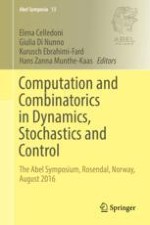The Abel Symposia volume at hand contains a collection of high-quality articles written by the world’s leading experts, and addressing all mathematicians interested in advances in deterministic and stochastic dynamical systems, numerical analysis, and control theory.
In recent years we have witnessed a remarkable convergence between individual mathematical disciplines that approach deterministic and stochastic dynamical systems from mathematical analysis, computational mathematics and control theoretical perspectives. Breakthrough developments in these fields now provide a common mathematical framework for attacking many different problems related to differential geometry, analysis and algorithms for stochastic and deterministic dynamics. In the Abel Symposium 2016, which took place from August 16-19 in Rosendal near Bergen, leading researchers in the fields of deterministic and stochastic differential equations, control theory, numerical analysis, algebra and random processes presented and discussed the current state of the art in these diverse fields.
The current Abel Symposia volume may serve as a point of departure for exploring these related but diverse fields of research, as well as an indicator of important current and future developments in modern mathematics.
